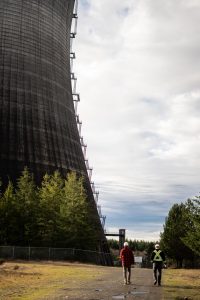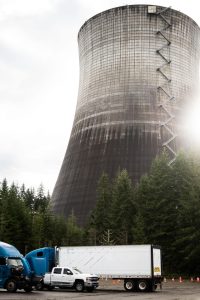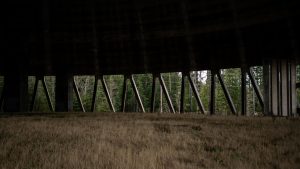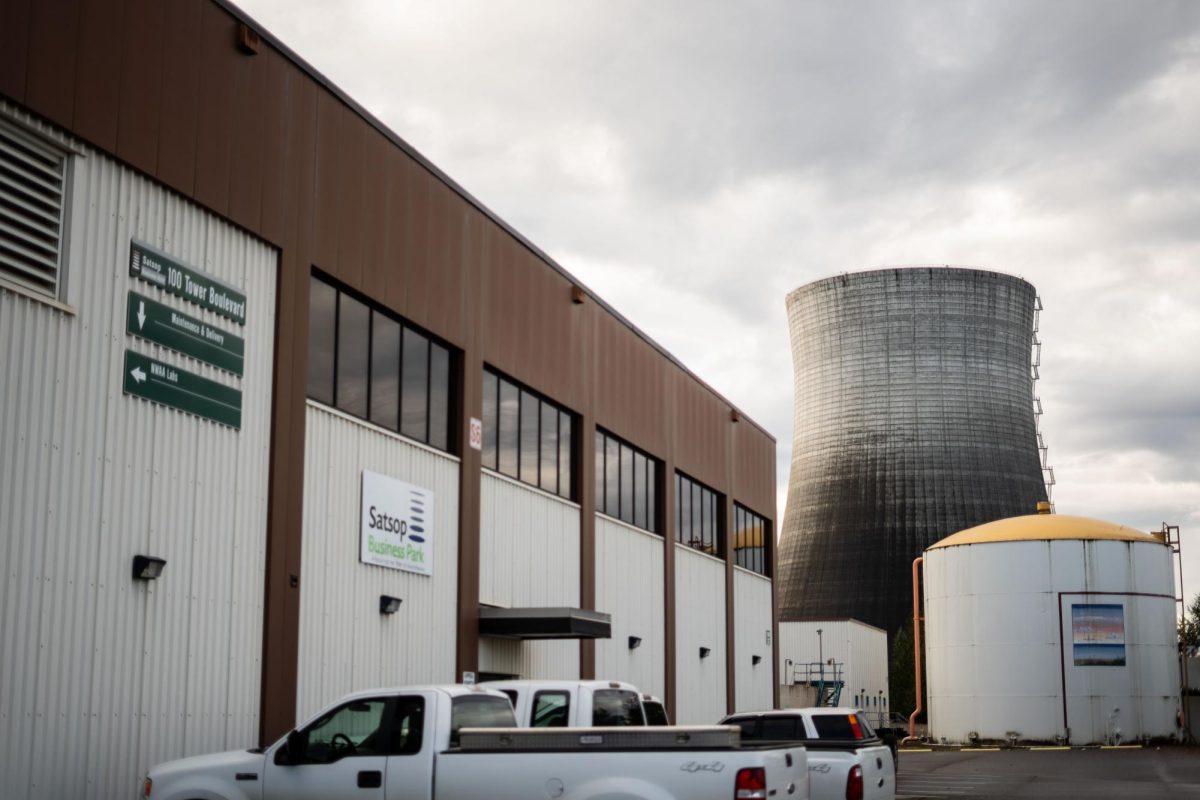
Looming hundreds of feet above the rural forest of Washington State’s Grays Harbor County stand two immense cooling towers, the grim remnants of the budgetary failure that destroyed a community. A ghost of the brief American obsession with nuclear power and perhaps the greatest governmental failure in state history, the facility is as historically significant as it is ominous.
Nuclear technology was never seriously explored in the United States until the development of the atomic bomb and the sudden end of the Second World War. But as the nation entered an era of unprecedented economic prosperity, the need for energy increased correspondingly. Nuclear power was the new kid on the block, and as a hugely efficient source of clean power, the potential seemed limitless.
The Washington Public Power Supply System (WPPSS) saw its chance in 1973. Managing director Neil Strand was the first head of the organization with previous nuclear experience, and he wasted no time in commissioning five nuclear power plants. The Satsop site was originally intended to hold two of the facilities, officially titled WNP-3 and WNP-5.
To an onlooker, the rural and relatively impoverished Grays Harbor County seems an unusual place for a gigantic nuclear facility. Nancy Cuyle, secretary of local historical organization Friends of the Aberdeen Museum and longtime resident, provided insight as to why Satsop was chosen.
“Because [Grays Harbor County] was depressed, they could get a lot of local help at a relatively cheap rate,” Cuyle said. “People were looking for jobs so it was a win-win. And when you have that kind of situation you don’t have people screaming ‘don’t put the nukes near us’ like you would in a place where people can’t afford to say no.”
The multibillion-dollar construction project started in 1977 and morale was generally high in Grays Harbor County. In addition to providing an unprecedented employment opportunity, WPPSS had chosen to fund the plant with municipal bonds, seen at the time as the safest investment opportunity available.

Alex Cruz, a third-year business and law student, noted the perceived stability of bonds as a driving factor behind their popularity.
“Typically [bonds] are safe because they’re tied directly to the government,” Cruz said. “They don’t rely on companies doing well and instead rely on what the government is doing.”
This fundraising effort would eventually raise WPPSS a staggering $2.25 billion for construction on the plant. But almost immediately, cracks in the plan started to show. Alissa Shay, general manager of Satsop Business Park, cited three factors that hit WPPSS hard.
First, due to federal environmental reforms and rising public consciousness about energy conservation, the power demands of western Washington were far below what WPPSS had predicted. This essentially eliminated the need for the plant in the first place. Second, the Three Mile Island nuclear meltdown in Pennsylvania had harshly reinforced the dangers that came from living in close proximity to a nuclear facility. Third, and most importantly, WPPSS was suffering from huge, inexcusable cost overruns.
While some factors were unforeseeable, such as the rapid inflation that occurred in the 1970s, WPPSS made other appalling errors. Strand and the rest of the organization elected to pursue a fast-track construction model and began building the plant before finishing design and engineering processes. The fast-track method can reduce building time, but is typically used only in projects that are highly familiar, have low cost variance, and are unlikely to change in the course of design. The Satsop project was none of these, and costs at the site began to skyrocket. Popular support for the plant cratered and WPPSS was lampooned in local media with the pejorative nickname “whoops,” as money continued to vanish without any end in sight.
In addition, WPPSS shot themselves in the foot with specific design choices. Cuyle pointed out that instead of building the same plant twice, the organization made the confounding decision to build WNP-5 completely disparate to WNP-3.

“During the construction there were some really poor decisions made. The two plants were 180 degrees different—no part from one plant can be used in the other plant. They had to sort every part for Plant 1 or Plant 2… and the recordkeeping was absolutely horrendous,” Cuyle said.
By 1981, WPPSS was in freefall. Satsop’s initial cost estimate of $4.1 billion had ballooned to over $24 billion. WNP-3 was nowhere close to complete and construction on WNP-5 had barely begun. Strand and the rest of the project management team had either resigned or been fired the year prior. Grays Harbor County was also being devastated by a national recession that left unemployment at record highs. As demand for work on the plants nosedived, more and more people found themselves suddenly jobless.
Making this worse was the fact that the already impoverished region had enthusiastically purchased municipal bonds to support the plant half a decade earlier. For many residents of Grays Harbor County, the seemingly infallible investment functioned as a retirement plan or a fund for their children, as well as a chance to support economic growth in the region for future generations. In 1983, WPPSS formally announced what bondholders had been dreading—they were never going to be able to pay back the $2.25 billion of bonds. Even now, 40 years later, it remains the second largest municipal bond default in American history.
“When it went down, people just went insane,” Cuyle said. “I mean everybody—the Girl Scouts in Olympia invested all of their money in WPPSS bonds and it literally destroyed them. A lot of people in Grays Harbor County did the same thing. It hurt the people here really really badly.”
It’s not an exaggeration to call the failure of the Satsop project one of the greatest governmental miscues in state history. Billions of dollars were wasted, a historically underserved community was left economically devastated, and a grand total of zero watts of power was produced.
The facility was dormant for a number of years, before being sold to the Grays Harbor Public Development Authority in 1998. The organization began brainstorming ideas for repurposing the old plant, settling eventually on a buisness park that would allow entrepreneurs a chance to take advantage of Satsop’s unique resources. Several clients, including two major call centers, called Satsop home for a number of years. In 2013, the facility would be sold again, this time to the Port of Grays Harbor.

“When I say there’s a lot of resources or pieces of infrastructure most people jump to thinking about the cooling towers or the reactor building,” Shay said. “But actually it was more about the other pieces of infrastructure. For example, we have the water rights for a nuclear power plant. 20 cubic feet per second, which is a lot of water.”
Shay also cited power reliability (the Satsop site is located directly adjacent to a substation) and over 700,000 square feet of warehousing space, as well as easy access off Highway 8 as other attractive factors to the Port. However, they still had to grapple with the site’s grim reputation. When port employees publicly associated with Satsop interacted with community members, the dialogue was often unproductive. Shay cites this friction as one reason the Port no longer offers public tours of the old nuclear facilities.
Some business owners were still willing to look past the negative community sentiment. When Dave Skaar opened Packaging Solutions, a manufacturing and packing company, he saw potential in the old site. Skaar made the decision to start his own company after 14 years with the Washington State Department of Health and Human Services, and Satsop gave him an excellent place to do it.

“The warehouse space is really good,” Skaar said. “We also have a little shop area because we actually service [client] equipment as well. We can help our customers stay operational.”
For some, the relatively remote location of Satsop is a non-starter as far as a business site. For others, such as Kirk Church, the isolation is a bonus. Church, who is an adjunct instructor at Grays Harbor College, teaches a commercial driver’s license (CDL) class directly under WNP-3’s colossal cooling tower.
“If I was to take these brand new students to start training them in Seattle, they have to deal with the close quarters, the commuting cars, and all of that. Up here, there’s not very many people,” Church said. “They get to experience hills and mountains… coming to stops and starting on hills. It’s a low-risk area.”
Church’s work serves a larger purpose than putting food on the table. A critical shortage of CDL drivers makes qualified educational opportunities in the field essential.
“In the state of Washington there’s somewhere around 5,000 CDL jobs that are open currently. Nationwide that number gets quite large,” Church said. “It’s a desired field.”
The vast cooling towers get most of the attention at Satsop. Both WNP-3 and WNP-5 have completed towers—the 496 foot tall concrete behemoths rising hundreds of feet over even the trees can be seen easily from the highway. In the plant’s heyday, they would have functioned as enormous chimneys, sending steam used to cool the reactor up into the sky. Today, the towers are rented out on an hourly basis to musicians and video game designers who make use of the apocalyptic scenery and the unique acoustic effects. A local sound engineer has a personal lab in the main facility where he can run acoustic tests. The dystopian appearance of the towers also holds appeal for filmmakers and game designers. Satsop sites served as the backdrop for scenes in two Transformers movies.
In total, the park has twenty other on-site clients. These include companies as diverse as a manufacturer of deluxe evergreen products, a natural gas plant, and a cannabis farm. 1,200 acres of Satsop is managed forest, which Grays Harbor College maintains. It was briefly home to the Grays Harbor County Superior Court during the COVID-19 pandemic for the purpose of holding socially distant jury trials, and is used by numerous companies for supply chain storage.

Progress has been mixed on the public opinion front. The pain of the economic damage wrought to the county is generational and still raw for many. However, the Port is starting to renew Satsop’s reputation.
“A little bit of [public goodwill] is coming back,” Cuyle said.
There is a true turnaround underway at Satsop. What was once a monument to governmental waste and irreparable economic damage to a tight-knit region is now a small but thriving community of businesses. Shay’s current focus is on expanding the park’s clientele, a move that stands to bring more jobs, commerce, and opportunity for the county.
“The main goals are trying to create jobs, attract private investment… and help our current customers grow,” Shay said.
Local citizens will never truly be compensated for the failures of WPPSS. But for the first time in four decades, Satsop is giving residents of Grays Harbor County something to look forward to.













